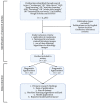Diagnostic and Prognostic Deep Learning Applications for Histological Assessment of Cutaneous Melanoma
- PMID: 36551716
- PMCID: PMC9776963
- DOI: 10.3390/cancers14246231
Diagnostic and Prognostic Deep Learning Applications for Histological Assessment of Cutaneous Melanoma
Abstract
Melanoma is among the most devastating human malignancies. Accurate diagnosis and prognosis are essential to offer optimal treatment. Histopathology is the gold standard for establishing melanoma diagnosis and prognostic features. However, discrepancies often exist between pathologists, and analysis is costly and time-consuming. Deep-learning algorithms are deployed to improve melanoma diagnosis and prognostication from histological images of melanoma. In recent years, the development of these machine-learning tools has accelerated, and machine learning is poised to become a clinical tool to aid melanoma histology. Nevertheless, a review of the advances in machine learning in melanoma histology was lacking. We performed a comprehensive literature search to provide a complete overview of the recent advances in machine learning in the assessment of melanoma based on hematoxylin eosin digital pathology images. In our work, we review 37 recent publications, compare the methods and performance of the reviewed studies, and highlight the variety of promising machine-learning applications in melanoma histology.
Keywords: deep learning; dermatopathology; melanoma.
Conflict of interest statement
The authors declare no conflict of interest.
Figures



Similar articles
-
Deep learning in computational dermatopathology of melanoma: A technical systematic literature review.Comput Biol Med. 2023 Sep;163:107083. doi: 10.1016/j.compbiomed.2023.107083. Epub 2023 May 29. Comput Biol Med. 2023. PMID: 37315382
-
Application of Deep Learning on the Prognosis of Cutaneous Melanoma Based on Full Scan Pathology Images.Biomed Res Int. 2022 Aug 28;2022:4864485. doi: 10.1155/2022/4864485. eCollection 2022. Biomed Res Int. 2022. PMID: 36072469 Free PMC article.
-
Artificial intelligence in dermatopathology: Diagnosis, education, and research.J Cutan Pathol. 2021 Aug;48(8):1061-1068. doi: 10.1111/cup.13954. Epub 2021 Jan 26. J Cutan Pathol. 2021. PMID: 33421167 Review.
-
Artificial intelligence as the next step towards precision pathology.J Intern Med. 2020 Jul;288(1):62-81. doi: 10.1111/joim.13030. Epub 2020 Mar 3. J Intern Med. 2020. PMID: 32128929 Review.
-
Superpixel-Based Conditional Random Fields (SuperCRF): Incorporating Global and Local Context for Enhanced Deep Learning in Melanoma Histopathology.Front Oncol. 2019 Oct 11;9:1045. doi: 10.3389/fonc.2019.01045. eCollection 2019. Front Oncol. 2019. PMID: 31681583 Free PMC article.
Cited by
-
Robust ROI Detection in Whole Slide Images Guided by Pathologists' Viewing Patterns.J Imaging Inform Med. 2025 Feb;38(1):439-454. doi: 10.1007/s10278-024-01202-x. Epub 2024 Aug 9. J Imaging Inform Med. 2025. PMID: 39122892 Free PMC article.
-
Overdiagnosis in Melanoma Screening: Is It a Real Problem?Dermatol Pract Concept. 2023 Oct 1;13(4):e2023247. doi: 10.5826/dpc.1304a247. Dermatol Pract Concept. 2023. PMID: 37992381 Free PMC article. No abstract available.
-
Diagnosis and prognosis of melanoma from dermoscopy images using machine learning and deep learning: a systematic literature review.BMC Cancer. 2025 Jan 13;25(1):75. doi: 10.1186/s12885-024-13423-y. BMC Cancer. 2025. PMID: 39806282 Free PMC article.
-
Review of Non-Invasive Imaging Technologies for Cutaneous Melanoma.Biosensors (Basel). 2025 May 7;15(5):297. doi: 10.3390/bios15050297. Biosensors (Basel). 2025. PMID: 40422036 Free PMC article. Review.
-
Utilizing deep learning model for assessing melanocytic density in resection margins of lentigo maligna.Diagn Pathol. 2024 Aug 3;19(1):106. doi: 10.1186/s13000-024-01532-y. Diagn Pathol. 2024. PMID: 39097745 Free PMC article.
References
-
- National Cancer Institute: Surveillance, Epidemiology, and End Results Program Cancer Stat Facts: Melanoma of the Skin. [(accessed on 19 May 2022)]; Available online: https://seer.cancer.gov/statfacts/html/melan.html.
-
- Rastrelli M., Tropea S., Rossi C.R., Alaibac M. Melanoma: Epidemiology, risk factors, pathogenesis, diagnosis and classification. In Vivo. 2014;28:1005–1011. - PubMed
Publication types
Grants and funding
LinkOut - more resources
Full Text Sources

